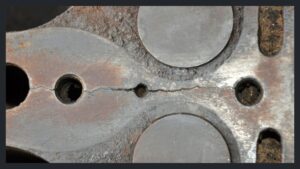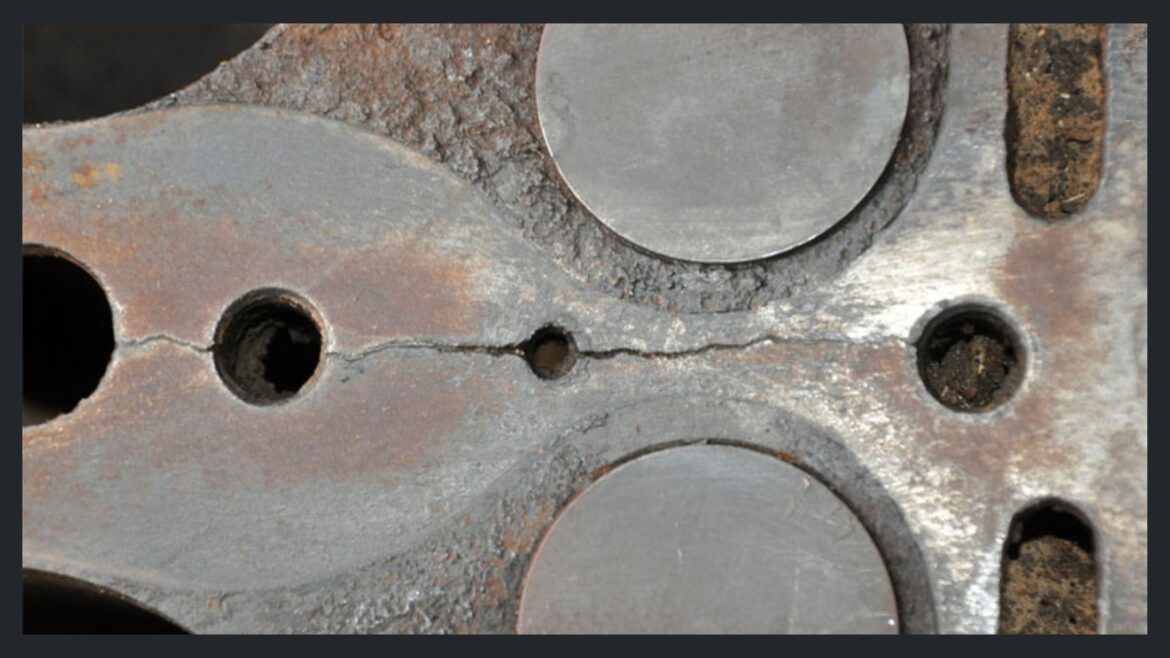
8 Symptoms of a Cracked Cylinder Head
The cylinder head is the “top end” of your engine. It connects to the engine block and seals off the combustion chamber where your engine burns fuel to create power.
The cylinder head also houses the valves that direct the air flow. The intake valve draws in fresh air, where combustion occurs, and then the exhaust valve expels the burnt mixture from the combustion chamber. An internal combustion engine is basically just a fancy air pump. Under extreme conditions, the cylinder head may actually crack. A cracked cylinder head can cause similar symptoms as a blown head gasket or a cracked block, but it will cost more to repair than a blown head gasket.
Symptoms of a Cracked Cylinder Head
Small cracks in the cylinder head may go unnoticed for a while, but if severe, the symptoms will be noticeable. Here are some of the most common symptoms to look out for if this occurs:
1) Oil Leaks
The cylinder head contains oil. If the cylinder head is cracked, it may leak oil. When this problem occurs, the oil light on the dashboard will come on, indicating low oil pressure.
If this light is on, open the hood and check if there is engine oil near the cylinder head. In some cases, oil may leak inside. In this case, you may not notice a puddle of oil, but you may see blue smoke coming from the exhaust.
2) Coolant leaks
Coolant leaks can cause cylinder head cracks, which are also a symptom. If your cylinder head has a large crack, it may be leaking coolant as well as oil.
This will cause the engine to overheat and will cause a warning to appear on your car’s dashboard. An internal leak of coolant may get into the oil passages and combustion chamber. Always check your coolant level and stop driving if there is a visible coolant leak or you notice that the coolant level is dropping rapidly over time.
3) Air bubbles in the radiator or overflow tank
If the cylinder head has a crack that allows combustion gases to enter the cooling system, air bubbles may appear in the radiator or coolant overflow tank. These bubbles are especially noticeable when the engine is running (but never open the radiator cap when the engine is already running or hot).
To check for this, remove the radiator cap when the engine is cold (such as first thing in the morning) and start the car. If you see persistent bubbling, this could indicate a crack in the cylinder head or a blown head gasket. Do not leave the engine running with the radiator cap removed for more than a few minutes. As the coolant temperature rises, it expands and eventually begins to flow out of the radiator opening.
4) Milky Oil
When a cylinder head crack develops, the coolant mixes with the engine oil, making it cloudy or foamy. This mixture is often described as a “milkshake” consistency and can be seen on the dipstick or oil filler cap. This is a clear sign of coolant contamination and should be addressed immediately, as simply ignoring it can cause serious damage to your engine.
5) Rough Idling
When a cylinder head crack causes uneven compression in the engine, you may experience a rough idle or the tachometer needle fluctuating erratically from time to time. The engine may shake or vibrate more than normal when the vehicle is stopped. This symptom worsens as the engine warms up, and heat often causes the cracks to enlarge.
6) Poor Engine Performance
A crack in the cylinder head can severely affect the performance of your engine. If compressed air leaks through the crack, you may notice reduced performance, slower acceleration, or difficulty maintaining speed.
Misfiring is also common and occurs when a crack prevents proper combustion. Your engine may stutter or stutter, especially at low speeds. If you experience these issues along with other symptoms such as coolant loss, have your vehicle inspected as soon as possible to avoid further damage.
7) Reduced Fuel Consumption
An engine with a cracked cylinder head will have to work harder to maintain performance, so it will use more fuel in the process. Keep track of how often you fill up.
8) Sweet smell coming from the exhaust
If coolant enters the combustion chamber through cracks in the cylinder head, you may notice a sweet, syrupy smell coming from the exhaust. This smell is characteristic of burning coolant and is often most noticeable when the engine is warming up. If you experience this smell along with the other symptoms listed on this page, please schedule a service appointment as soon as possible.

